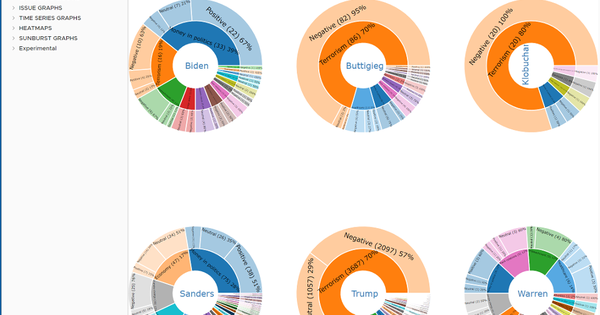
Big Data Analysis And Visualization Honed In Government Service Comes To You
“Right now we’re trying to catch disinformation campaigns,” said David Waldrop, CEO and Founder of ICG Solutions based in Potomac, Maryland. Waldrop is talking about his latest project in big data analysis that parses public social media data to spot campaigns that exist to sway public opinion through the use of false or inaccurate data.

Getty
At the heart of the new product, is LUX, a massive data analytics engine that can use millions of individual data streams from hundreds of sources. The new project, called “Ilumina Insight” is still in the development stages, but it depends heavily on publicly available data from social media to determine activities by bots, state-sponsored accounts and people known to spread disinformation.
This is just one aspect of LUX, which is widely used in government and industry. “ICG specializes in real-time analytics,” Waldrop explained, “beginning over 10 years ago working in national security with the intelligence community. The data-and domain agnostic LUX platform has been successfully used in multiple customers including DoD, state and local law enforcement, pharma, banking, and for a variety of detection and monitoring solutions such as threat analysis, elections, fraud and cyber security.”
October 27, 2019, the day that the White House reported the killing of a leader of ISIS, the topic of terrorism suddenly became the top item of concern on social media, rising above everything else including impeachment.
However, LUX is available to anyone who wants to use it through a cloud-based application called LUX 2020, which performs sentiment analysis using publicly-available data from three social media platforms, Twitter, Reddit and Gab. Unlike some social media mining programs in the past that depended on private profile data, the data used by LUX is limited to what’s available to anyone. It uses inference to determine information about a person’s gender, location, age and the like.
LUX 2020 performs its sentiment analysis on the candidates running for President in the 2020 election. You can use it to look at a candidate’s performance on a specific issue, an overall sentiment, sentiment in comparison to other candidates, overall influence and sentiment by race, gender, location and party, among other attributes.

Democratic presidential hopefuls, New Jersey Senator Cory Booker, California Senator Kamala Harris, … [+]
AFP via Getty Images
One fascinating use for LUX 2020 is to watch it track how sentiments change in real time as significant actions occur. For example, on Sunday, October 27, 2019, the day that the White House reported the killing of a leader of ISIS, the topic of terrorism suddenly became the top item of concern on social media, rising above everything else including impeachment.
The following day, that level of concern fell back to nearly its previous level. During this time, the positive and negative sentiment regarding Donald Trump did not change, showing in real time that his overall support probably didn’t change. It’s worth noting that this information is available well in advance of polling data, but previous research on poll results has shown that it tends to follow voter sentiment a few days later.
There are important difference between sentiment analysis and polling. Other than the timeliness of sentiment analysis when used by LUX, polling as it’s conducted these days has a few challenges. Those include a skewed sample because it selects only people with landline telephones which cuts out many millennials and rural poor. It also includes inaccurate data because people sometimes lie to pollsters. On the other hand, the inferences used by LUX to determine gender, location or age may be wrong. But Waldrop thinks that the overall results are more accurate. “We’re getting them where they live,” he said.
The LUX 2020 application has a number of pre-made analyses, but it also allows the creation of rules for customized analysis. You can, if you wish, compare the sentiment towards Joe Biden in the 6th Congressional district of Virginia by males between 18 and 35. Or you can look at sentiment regarding impeachment or abortion in the same district.
Another powerful feature of LUX 2020 is its visualization ability. There is a vast selection of graphic elements that are created for you, and you can select what appears in those elements. But you can also define your own and visualize them in a way that you prefer. Using LUX 2020 while you watch the next round of debates will be interesting.

Sentiment visualization of six top presidential candidates on the day the White House announced the … [+]
LUX 2020 via Wayne Rash
But be prepared for the contrast between Donald Trump and other candidates. One thing you can’t miss is the disparity in overall numbers. As this is written in October, 2019, it’s clear that Trump owns the social media platforms for his own messaging. Other candidates on both sides need to do a lot of work to catch up.
Waldrop has also announced another application for the LUX engine, this time focused on cyber security. Called Clairvoyance, the new application analyzes corporate and social media data for insight on insider threats. The Clairvoyance application produces a score for every employee every day as it looks for indications of isolation or concealment and other motivations to breach company data.
“We hope that will cause a reset,” Waldrop explained, “and maybe your employee won’t want to sell your data to the Chinese.” He said that by using data from Clairvoyance, managers can seek out employees who need more engagement to feel better about the organization.
The fact that LUX operates in real time can be critical for organizations when decisions must be made. Drawing on his experience with his military customers, Waldrop explains, “Commanders want more time to make decisions and they want as much information as possible.” The same applies to managers at all levels of business.






